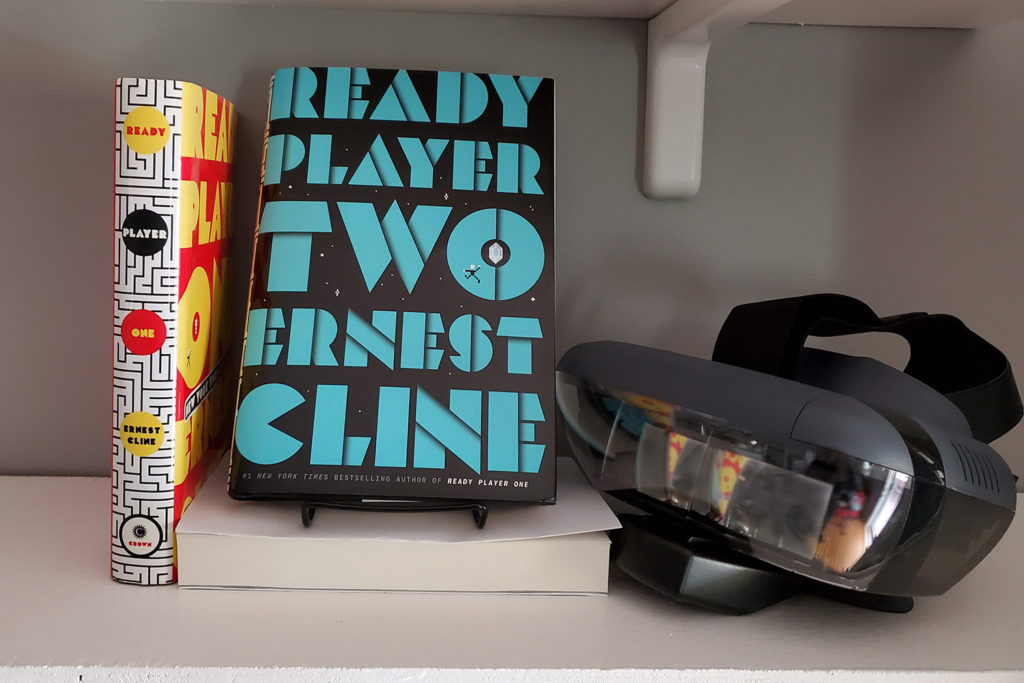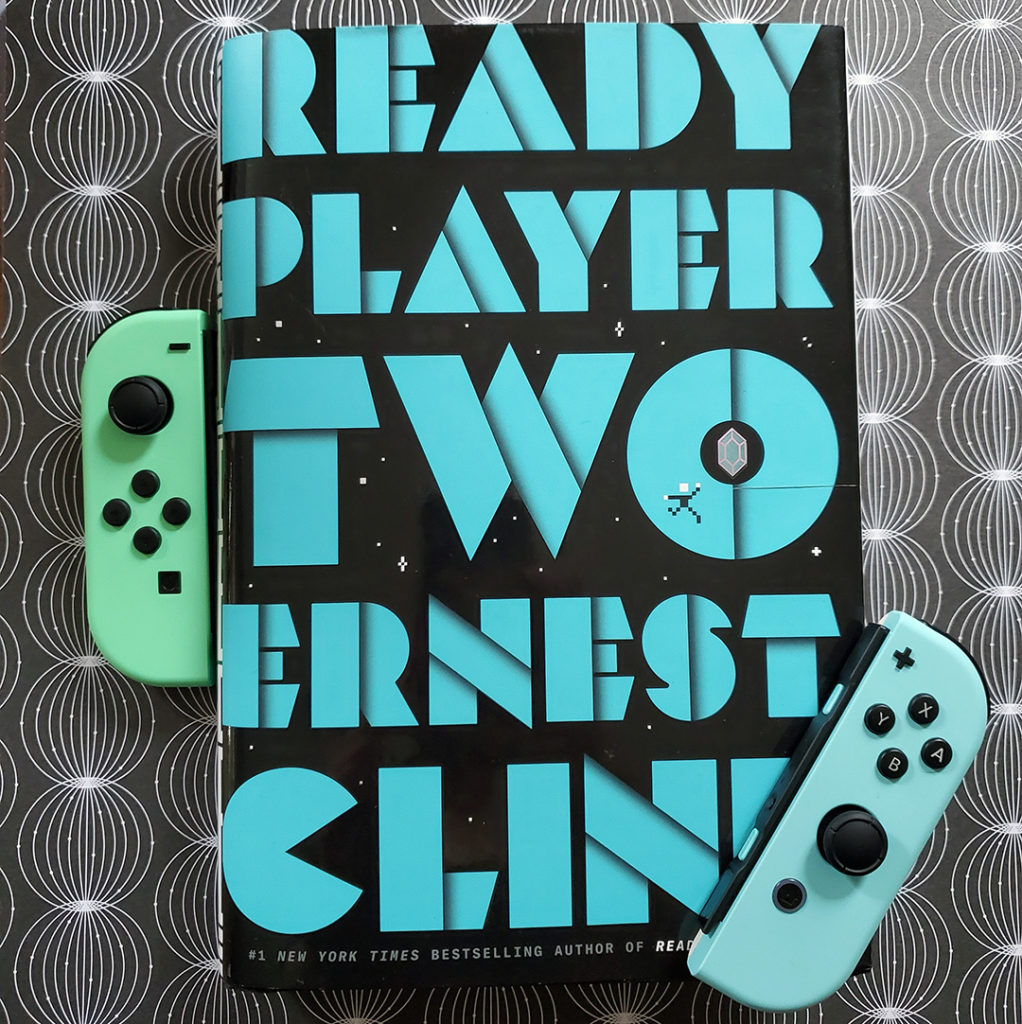This week’s book review covers Ready Player Two by Ernest Cline, the follow up to his 2011 bestseller Ready Player One. This post contains affiliate links to Bookshop.org, an online bookstore that financially supports local independent bookstores.

The Book Witch’s One-Sentence Review
Ready Player Two is a fast-paced and fun—though imperfect—nostalgia-fueled romp that explores deeper themes of toxic masculinity and the repercussions of virtual reality and artificial intelligence.
A Brief Recap of Ready Player One
In case you haven’t read the book or seen the movie (or it’s just been awhile), there are a couple things you need to know. James Halliday, who grew up in the ‘80s, created the virtual reality world the OASIS. After his death, his OASIS avatar Anorak—now a program that runs autonomously—revealed that whoever could solve the puzzle he designed would inherit Halliday’s real world wealth and an owning stake in his company. Because the stakes are so high, pretty much everyone is trying to solve the puzzle, including Wade Watts, aka Parzival, our main character, and his merry gang of friends, Art3mis, Aech, Daito, and Shoto.
People seem to either hate or love Ready Player One, Ernest Cline’s nerdy love letter to the ‘80s and early video games.
The book’s detractors say it’s just nostalgia porn with no real purpose, while those who connect with it see a bit more nuance in the storytelling and a deeper message than just “the ‘80s were cool.”

I loved Ready Player One—it has some flaws, but it’s a hoot to read—and particularly liked how Ernest Cline addresses toxic masculinity and gatekeeping in nerd culture.
At the beginning of the book, Wade/Parzival is an awkward nerd boy with a chip on his shoulder who spends all his time playing video games and trying to solve Halliday’s quest. By the book’s end, Wade has had to confront his own toxic tendencies, and the imperfect legacy of his idol, James Halliday. He’s also had to learn how to be a better friend.
This character growth elevates the book above nostalgia-fueled-romp to something with more meat and consequence, at least in my opinion. Wade wins Halliday’s contest with more than a little help from his friends, but splits his winnings with them evenly. He also, of course, wins Art3mis/Samantha over and they begin a relationship in the real world at the end of the book.
Press Start to Read This Review of Ready Player Two
At the beginning of Ready Player Two, we find Wade once again bitter and broken. Samantha has broken up with him, and he’s grown distant from Aech and Shoto. He is, to put it mildly, a hot mess who’s once again become addicted to the OASIS—only now, with the OASIS Neural Interface (ONI) headset, he can plug his brain directly into the machine, making the addiction even stronger.

A number of reviewers, particularly on Goodreads, decried this as an “erasure” of Wade’s character development from the first book. I disagree. By the end of the first book, Wade had only just learned how to be a better person. Suddenly, he’s been given the keys to the kingdom, more money than he knows what to do with, and a level of fame that proves to be uncomfortable for him.
He does what many celebrities in this position have done before him: He backslides. He falls into old habits. His wealth and fame allow him to get away with behaviors he couldn’t before. He knows it’s wrong, and he knows these behaviors are why Samantha broke up with him. But he can’t seem to help himself, so we find him wallowing in shame, pity, and loneliness.
In gaining wealth, fame, and power, Wade has lost everything that was actually important to him, and Ready Player Two is the story of him fighting to get those things back.
Far from “erasing” his character development, Cline reminds us that growth isn’t a linear process. Change is hard. It’s work. And it’s easy to fall back on old habits when things get difficult—or too easy.
Is RP2 a Rehash of RP1?
Another common complaint I’ve seen about this sequel is that it’s just a repeat of the first book, but worse. I’ll get to that momentarily.
The book’s main plot kicks off when Anorak, James Halliday’s avatar, returns suddenly and informs Wade, Samantha, Aech, and Shoto that he’s made it impossible for anyone using an ONI headset to log off of the OASIS, which will cause irreparable brain damage after twelve hours of constant use. Anorak will only release his hostages if the gang is able to solve Halliday’s second puzzle: a quest for the seven shards of the Siren’s Soul.
(The siren refers to Kira Morrow, the woman James Halliday was in love with, but who instead loved and married Halliday’s partner, Ogden Morrow.)
Samantha has refused to use the ONI headsets, but Wade, Aech, and Shoto have embraced the technology. Being unable to log off and facing probable death makes them particularly motivated to find the seven shards. Despite the strain Wade’s behavior has put on their relationships, they all set out together to complete this new quest.

And this is where, yes, Ready Player Two echoes Ready Player One. But Two also takes the questions raised about the consequences of virtual reality in One and takes them to their next logical step: the question of AI. Anorak is a rogue AI, and while it seems like just another “robots bad” plot, it actually becomes much, much more complex.
That complexity, and the nuance with which Cline explores the problem, process, and repercussions of digitizing human consciousness, means I disagree with the assessment that Two is just a rehash of One. One asks “What if,” and Two follows it up with, “Okay, and then what if?”
The Glitch in the Code
None of this is to say Ready Player Two is a perfect book. The way each of the seven quests lined up perfectly with one of the party members’ expertise felt a little too perfect. And while I enjoyed the shard quest that took place on an OASIS world dedicated to Prince, it should have been at least twenty-five percent shorter.
Cline also introduces a transgender character in Ready Player Two, but the way in which he reveals L0hengrin is trans felt forced and awkward. Instead of simply letting us infer Lo was trans, and by extension just letting her be trans, he has Wade use his admin powers to look up her real-world identity and history. Wade doesn’t do this with any other character, and it felt a little bit too much like Cline wanted to make extra sure we knew that Lo is trans, instead of trusting the reader to figure it out.
Despite these issues, Ready Player Two delivers in the most important way: It’s a fun, nostalgia fueled romp that continues the first book’s exploration of toxic masculinity, jealousy, friendship, and what it means to be human.
If you’ve read Ready Player Two, what did you think? Let me know in the comments or on Twitter @bookwitchblog!
